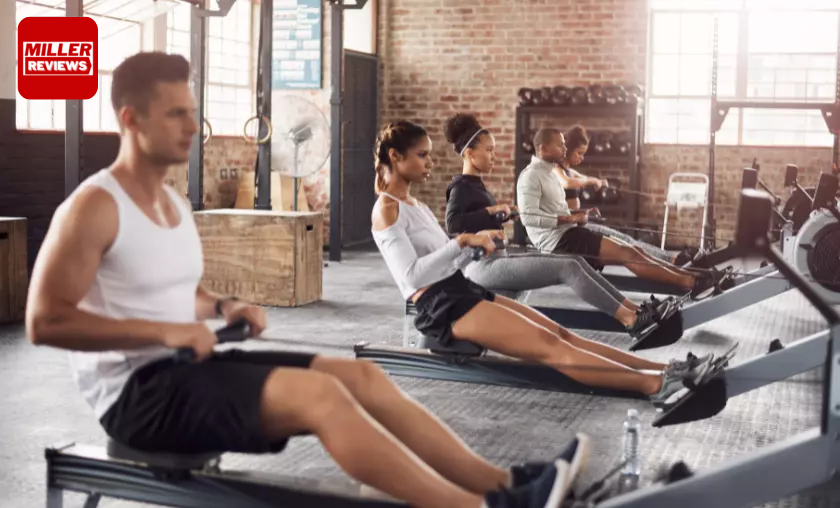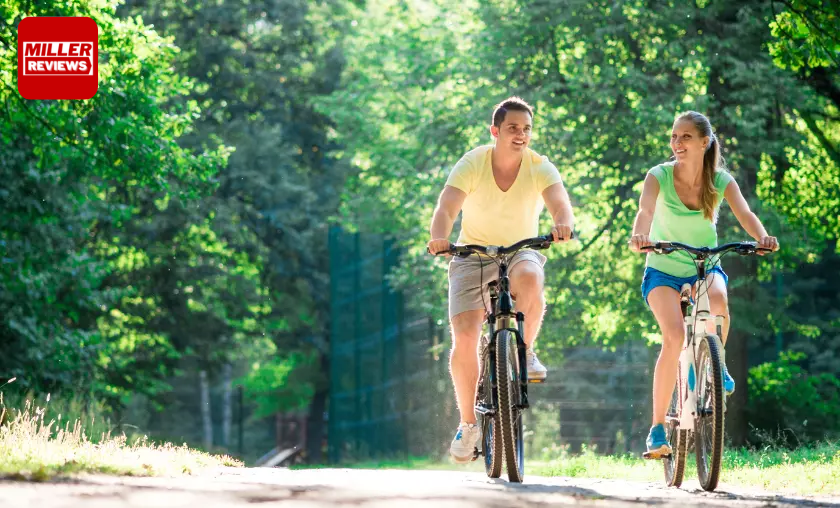If you are new to the world of fitness, easing your way back into the game, or dealing with joint issues or injuries, Fat-Burning Low-Impact Exercises cardio is the way to go. It’s a safe & effective way to get your body moving.
Low-impact exercises allow you to work out without putting excessive stress or strain on your joints. But don’t let the term “low impact” fool you – these workouts will still make you break a sweat!
Table of Contents
Here, we’ve handpicked 5 low-impact cardio workouts that will challenge your cardiovascular endurance and muscles. They’re great for beginners and those with joint concerns and serve as excellent cross-training options for athletes who want to keep active on their recovery days.
5 Fat-Burning Low-Impact Exercises Good for Knees
1. Join a Gym & Go Swimming

Let me share you about the king of joint-friendly exercises: swimming! It’s an incredibly low-impact option that will still make those calories burn. When you dive into the water, the buoyancy takes away the stress on your body by providing support. But don not think for a second that it’s an easy, mindless workout. Swimming combines the benefits of cardio, strength, and flexibility all in one.
Even if you stick to the basic freestyle stroke, you’ll engage muscles all over your upper and lower body. Your shoulders, triceps, pecs, and quads get a fantastic workout, not to mention your core.
Swimming is one of the best exercises you can do. The cherry on top? You’ll be amazed at the calories you can torch. For example, a 155-pound person can burn around 216 calories in just 30 minutes of swimming. If you weigh around 185 pounds, it’s even more impressive at about 252 calories burned (1). Dive in and enjoy the incredible benefits!
2. Keep One Foot on the Ground & Take a Walk

Let’s talk about the wonders of Walking. It’s an exercise that takes effort to beat when it comes to simplicity and effectiveness. Not only is it low impact, putting less strain on your knees compared to running or jogging, but it’s also a calorie-burning powerhouse. And here’s a little secret: walking on a track or a trail can be even gentler on your joints than walking on concrete.
If you want to kick it up a notch and boost your calorie burn, focus on generating power from your legs and hips. Engage those abdominal muscles and push the ground behind you to accelerate your pace. For an extra metabolic boost, bend your arms at the 90-degree angle and keep them close to your torso. This way, you’ll channel additional energy into your lower body, where those bigger muscles reside.
Now, let’s talk numbers. If you’re a 155-pound person walking fast (covering a 15-minute mile, approximately 4 miles per hour, or 6.43 km per hour) for 30 minutes, you can expect to burn around 175 calories. If you weigh around 185 pounds, your effort at the same level will torch approximately 189 calories (1). Lace-up your shoes, hit the pavement, and enjoy the benefits of this incredible exercise!
3. Focus on Rowing at the Gym

Let’s dive into another amazing exercise that delivers both a total-body strength and cardio workout: rowing. Rowing is a non-weight-bearing exercise, making it an excellent choice for individuals with joint concerns. It’s a fantastic option for pumping your heart and strengthening your entire body.
You’ll need access to a rowing machine to get started with rowing. This typically means heading to the gym, where you can find these machines readily available. However, if you prefer the convenience of exercising at home, there are rowing machines available for purchase at various price points. Check out our latest recommendations for the best rowing machines on the market today.
Rowing is a fantastic way to engage multiple muscle groups while increasing your heart rate. So, rowing is an exercise worth exploring whether you’re looking to build strength, improve your cardiovascular fitness, or switch up your routine. Get ready to row your way to a stronger, healthier you!
Keep proper form
- Take a seat on the rower, secure your feet on the platform by bending your knees, and grasp the handlebar. Keep your shins vertical, slightly lean your upper body forward over your legs, and keep your arms straight.
- Pushing against the platform to extend your legs. Engage your core, lean your upper body back at a 45-degree angle, and complete the motion by bending your elbows & pulling the handle towards your chest.
- To return, reverse the order of the previous steps: straighten your arms, allow your upper body to move toward the platform, and, once your hands pass your knees, bend your legs and return to the starting position.
Calories burned: Rowing at a moderate pace, a 155-pound person can torch around 252 calories in 30 minutes, while a 185-pound person can burn about 292.
4. Go for a Spin

whether you’re rocking the stationary bike, joining a cycling class, hopping on the legendary Peloton, or embracing the open road on a traditional bicycle, get ready for a delightful sting in your muscles, heart, and lungs. Cycling knows how to pack a punch, my friends. Getting started in this exciting venture doesn’t have to drain your wallet, especially if you have access to a stationary bike. However, a little gear investment is necessary to take it to the next level.
The key to a successful cycling experience lies in finding the perfect bike fit. It’s all about comfort and protecting those precious joints. Beware of ill-fitted seats wreaking havoc on your knees when they’re too high, too low, too far forward, or too far back. Seek guidance from professionals at a dedicated bicycle shop, your cycling class instructor, or a personal trainer at the gym.
When you’re in the saddle, your knees should maintain a slight bend at their fullest extension during a single revolution. Keep those handlebars at a height that promotes good posture, allowing you to reach them comfortably without slouching.
5. Go for a Skate

Prepare for a workout that not only torches calories but also engages your lower body in a whole new way. Skating’s side-to-side motion is a fantastic counter-stimulus for your muscles and joints, which are accustomed to moving in the front-to-back, or sagittal, plane during activities like walking, running, or cycling. In simpler terms: When you put on those skates, your legs embark on a unique journey, experiencing a completely different kind of movement.
But that’s not all! Skating also targets those glutes, hip abductors, and inner thighs, giving them a fantastic workout. It’s a workout that effortlessly combines effectiveness and pure, unadulterated fun. Now, let’s talk about the calorie burn, shall we? Skating at a casual intensity, whether you choose roller skates or in-line skates, can torch approximately 386 calories for a 155-pound individual and a whopping 461 calories for someone weighing 185 pounds during a delightful 30-minute session
So, lace up those skates, my friend, and embark on a calorie-burning adventure that’ll make you feel like a kid again. Roller skating or in-line skating offers a refreshing change of pace and a workout that’s equal parts effective and enjoyable. Let the good times roll!
Conclusion
We have explored five phenomenal exercises that set your fat-burning engines on fire and show mercy to your precious knees. We’ve discovered the wonders of cycling, where the wheels carry you on a journey of intensity and exhilaration sans the joint stress of running.
We’ve glided through the joyful realm of roller skating and in-line skating, relishing the side-to-side motion that works wonders for your lower body. And let’s not forget the ever-graceful dance of swimming and the gentle embrace of yoga, both offering low-impact alternatives that keep your knees happy while melting away those unwanted pounds.
So, fear not, my friends, for you now possess the knowledge to embark on a fitness journey that harmoniously balances the twin goals of torching fat and preserving your knees. It is time to step into a world of exercise that is both kind and effective. Let these low-impact wonders guide you toward a healthier, fitter, and knee-friendly future. Your body will thank you, and your knees will rejoice in celebration.
FAQs
How Can I Ensure Proper Form and Technique While Engaging in These Exercises?
Proper form & technique are crucial for maximizing the benefits of any exercise while minimizing the risk of injury. To ensure you’re performing these low-impact exercises correctly, consider the following tips:
Seek guidance: If you’re new to these exercises, consider working with a qualified fitness professional or attending a class led by an experienced instructor. They can provide guidance on proper form, technique, and modifications tailored to your specific needs.
Start slowly: Begin with a focus on mastering the correct form rather than rushing through the movements. Pay attention to alignment, posture, and targeted muscle groups.
Engage your core: Core engagement is essential for stability and proper alignment during these exercises. Focus on maintaining a strong core by drawing your navel toward your spine and avoiding excessive arching or rounding of the back.
Listen to your body: If you experience pain or discomfort, adjust the movement or intensity to a comfortable level. Push yourself, but not to the point of pain or strain.
Remember, it’s better to prioritize quality over quantity. Practicing proper form and technique maximize the benefits and reduce the risk of injury.
Are There Any Specific Modifications or Adaptations for Individuals With Knee Issues?
Absolutely! These low-impact exercises are chosen specifically to be gentle on the knees. However, if you have pre-existing knee issues or concerns, it’s always wise to consult with a healthcare professional or physical therapist before starting any exercise program.
They can provide personalized recommendations and modifications based on your specific needs and condition. Some common modifications may include reducing the range of motion, using additional support such as resistance bands or props, or opting for seated variations of the exercises.
What Are the Recommended Durations and Frequencies for Performing These Exercises?
The recommended durations and frequencies for these low-impact exercises can vary depending on your fitness level, goals, and overall schedule. As a general guideline, aim for at least 150 minutes of moderate-intensity exercise or 75 minutes of vigorous-intensity exercise per week, as recommended by health organizations.
This can be achieved by breaking it down into manageable sessions, such as 30 minutes of exercise on most days of the week. However, listening to your body and gradually increasing duration and frequency as your fitness level improves is essential.
Can I Incorporate These Exercises Into a Comprehensive Workout Routine?
Absolutely! These low-impact exercises can be excellent additions to a comprehensive workout routine. They offer a balance of cardiovascular benefits, muscle toning, and overall strength building.
To create a well-rounded workout routine, consider incorporating other forms of exercise, such as strength, flexibility, and high-intensity interval training (HIIT), if it aligns with your goals and abilities. By combining different types of exercises, you can target various muscle groups, enhance your overall fitness, and keep your workouts exciting and enjoyable.
Are There Any Precautions That I Should Take Before Engaging in These Exercises?
While these low-impact exercises are generally safe for most individuals, taking some precautions before starting any new exercise program is always prudent. Here’re the few tips to keep in mind:
Consult with a healthcare professional: If you’ve any underlying health conditions, are pregnant, or have any concerns about your physical fitness, it’s wise to consult with a healthcare professional before starting a new exercise program.
Warm-up and cool down: Prioritize a warm-up session before diving into these exercises to prepare your body for movement and prevent injuries. Similarly, remember to cool down and stretch afterward to promote muscle recovery and flexibility.
Listen to your body: Pay attention to any signals of pain, discomfort, or excessive fatigue. If something doesn’t feel right, modify the exercise or stop if necessary. It’s essential to honor your body’s limits and avoid pushing yourself beyond what is safe and comfortable.
Use proper footwear and equipment: Ensure appropriate footwear provides support and stability. Invest in any recommended equipment or accessories to enhance your safety and performance if necessary.
Taking these precautions and listening to your body create a safer and more enjoyable exercise experience.
For More amazing articles related to Fitness Check out our website Over Here
To Read more similar articles click here
Thanks for visiting our Website. If you appreciate our work, kindly show us some support in our comments section 🙂